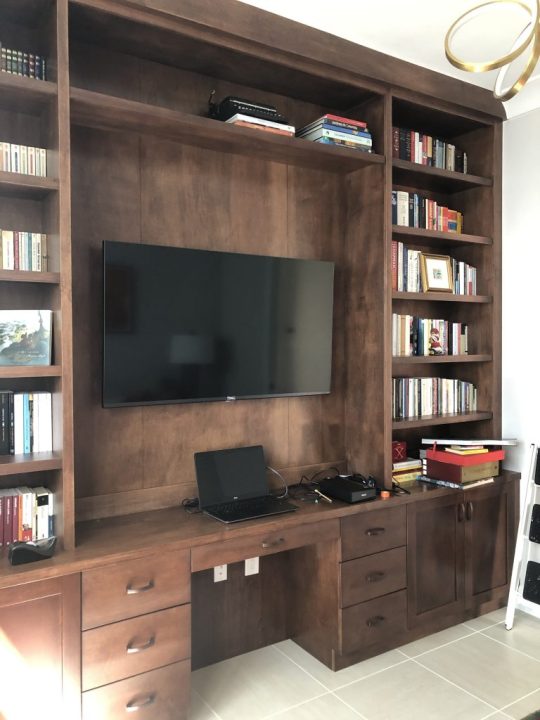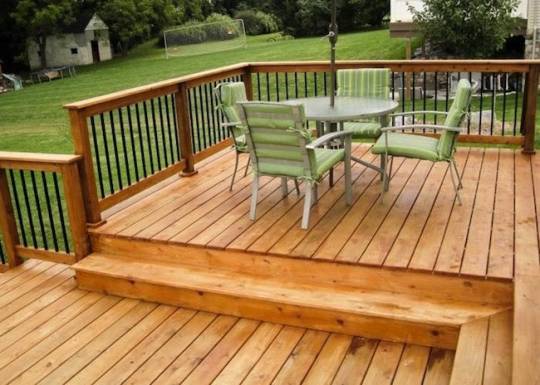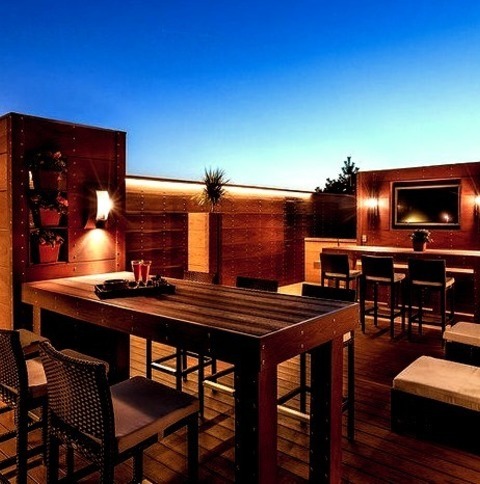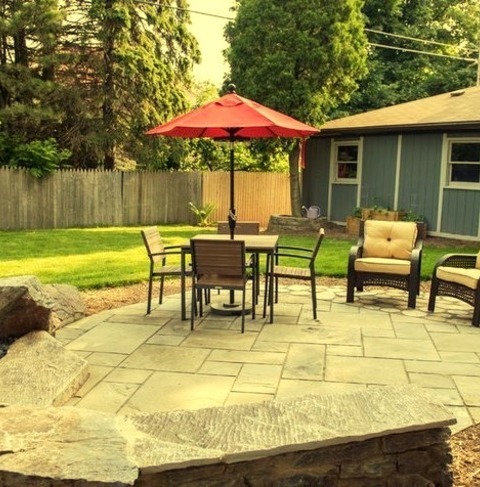#wood decking
Photo

Portland Maine Porch
Mid-sized traditional front porch design with decking and an addition to the roof
2 notes
·
View notes
Text
Wood Decking Boca Raton
Hire the Best Deck Builders in Boca Raton!

Are you looking for wood decking Boca Raton services?
Custom Carpentry Solutions offer reliable quality wood decking solutions at competitive prices.
Connect with us at 561-223-8823 and request a quote today.
5 notes
·
View notes
Text
Elevate Your Outdoor Space with Modern Wood Decking

In the realm of outdoor living, few features can rival the timeless allure and practicality of a well-designed wood deck. Whether you're envisioning a tranquil spot for morning coffee, a gathering place for friends and family, or simply a serene extension of your indoor space, modern wood decking offers a versatile canvas for creating the outdoor oasis of your dreams. Let's explore why wood decking remains a popular choice, delve into modern design trends, and uncover the benefits of incorporating this classic element into your home's exterior.

The Enduring Appeal of Wood Decking
Wood has long been cherished for its natural beauty and durability, making it a beloved material for decking. The organic warmth of wood effortlessly complements various architectural styles, from traditional to contemporary, adding a touch of rustic elegance to outdoor settings. Beyond aesthetics, wood decking boasts several advantages that contribute to its enduring popularity:
Durability: When properly maintained, high-quality wood decking can withstand the elements and endure for decades, making it a worthwhile investment for your home.
Versatility: Wood decking can be customized to suit your preferences, whether you prefer a rich, dark hardwood like mahogany or the classic appeal of cedar or redwood.
Sustainability: Opting for sustainably sourced wood or composite materials derived from recycled wood fibers can align with eco-friendly values.

Natural Beauty: Unlike synthetic alternatives, wood decking ages gracefully, developing a unique patina that adds character over time.
Modern Trends in Wood Decking
While traditional wooden decks remain timeless, modern design trends have introduced innovative approaches to wood decking, blending functionality with contemporary aesthetics. Here are some trends reshaping the landscape of modern wood decking:
Minimalist Profiles: Clean lines and uncluttered surfaces characterize modern wood decking designs, emphasizing simplicity and sophistication.
Mixed Materials: Incorporating materials like metal, glass, or concrete into the deck's structure or railing can create striking visual contrasts and enhance durability.
Integrated Lighting: Built-in LED lights or discreet fixtures integrated into the deck's surface lend ambiance and extend usability into the evening hours.
Multi-Level Decks: Tiered or multi-level decking configurations maximize space utilization and create distinct zones for dining, lounging, and entertaining.

Creative Deck Patterns: Intricate geometric patterns or alternating wood tones can transform a basic deck into a captivating focal point. You can click on this website for more details about modern wood decking.
Conclusion
In the realm of outdoor design, modern wood decking continues to captivate homeowners seeking a harmonious balance of beauty, functionality, and sustainability. Whether you're envisioning a sleek urban retreat or a rustic countryside escape, a well-executed wood deck can transform your outdoor space into a cherished sanctuary. Explore the myriad possibilities of modern wood decking, embrace innovative design trends, and reimagine your outdoor living experience with this enduring symbol of natural elegance.
1 note
·
View note
Text
Wood Decking: The Complete Guide

Wood decking has been a quintessential feature of outdoor living spaces for centuries, providing a natural, warm aesthetic that enhances any backyard or outdoor area. From classic redwood to exotic hardwoods, the options for wood decking are as diverse as the landscapes they adorn. In this comprehensive guide, we delve into everything you need to know about wood decking, from choosing the right type of wood to maintenance tips and design considerations.
Types of Wood for Decking
Cedar: Known for its natural resistance to decay and insects, cedar is a popular choice for decking. It boasts a rich color palette and aromatic scent, making it an attractive option for those seeking a rustic charm.
Redwood: With its distinct reddish-brown hue and durability, redwood is prized for its natural beauty and longevity. It's resistant to decay and warping, making it well-suited for outdoor use.
Pressure-Treated Lumber: Treated with chemicals to enhance durability and resistance to decay, pressure-treated lumber is a cost-effective option for decking. It's available in various grades and can be stained or painted to match your desired aesthetic.
Tropical Hardwoods: Exotic hardwoods such as ipe, cumaru, and tigerwood offer unparalleled strength and durability. While they come at a higher price point, their exceptional resistance to rot, insects, and weathering make them a popular choice for premium decking projects.

Choosing the Right Wood
Consider Durability: Assess the durability and resistance of different wood species to factors such as rot, insects, and moisture. Opt for woods with natural resistance or those treated to enhance longevity.
Aesthetic Appeal: Choose a wood species that complements your outdoor space and aligns with your design preferences. Consider factors such as color, grain pattern, and texture when making your selection.
Maintenance Requirements: Evaluate the maintenance needs of different wood types, including staining, sealing, and periodic inspections. Select a wood decking material that fits your lifestyle and maintenance preferences.
Deck Construction and Design
Deck Layout: Plan the layout and dimensions of your deck to maximize space utilization and functionality. Consider factors such as traffic flow, seating areas, and outdoor amenities when designing your deck.
Structural Support: Ensure proper structural support for your deck by using pressure-treated lumber or steel framing. Follow local building codes and regulations to ensure safety and compliance.
Decking Patterns: Explore different decking patterns such as traditional straight boards, diagonal layouts, or herringbone designs to add visual interest and character to your deck.
Railings and Accessories: Enhance the safety and aesthetics of your deck with stylish railings, lighting fixtures, and accessories. Choose materials that complement your decking material and overall design scheme.
Deck Maintenance Tips
Regular Cleaning: Keep your wood deck clean by sweeping away debris and dirt regularly. Use a mild detergent and water to scrub away stains and mold growth as needed.
Sealing and Staining: Apply a protective sealant or stain to your wood deck every 1-3 years to enhance durability and weather resistance. Choose products specifically formulated for outdoor use and follow manufacturer instructions for best results.
Inspections and Repairs: Conduct routine inspections of your deck for signs of damage, including rot, decay, and loose boards. Promptly repair any issues to prevent further damage and maintain structural integrity.
Seasonal Care: Take seasonal precautions to protect your wood deck from harsh weather conditions such as snow, ice, and UV exposure. Consider covering or storing outdoor furniture during inclement weather to prevent damage to the deck surface.
youtube
Frequently Asked Questions
How do I choose the right type of wood for my deck?
Consider factors such as durability, aesthetics, and maintenance requirements when selecting smooth double wood decking. Opt for wood species with natural resistance to decay and insects, such as cedar or redwood, for longevity. Additionally, assess your willingness to invest time and effort into maintenance tasks like sealing and staining.
What is the difference between pressure-treated lumber and untreated wood for decking?
Pressure-treated lumber undergoes a chemical treatment process to enhance its durability and resistance to decay, insects, and moisture. Untreated wood, on the other hand, lacks this protective treatment and may be more susceptible to rot and insect damage over time.
How often should I maintain my wood deck?
Regular maintenance is essential to prolonging the lifespan and appearance of your wood deck. Conducting routine inspections for signs of damage and addressing issues promptly can also help prevent costly repairs down the line.
Can I install a wood deck myself, or do I need to hire a professional?
The decision to install a wood deck yourself or hire a professional depends on your level of experience, available time, and comfort with construction tasks. Hiring a professional contractor ensures proper installation, adherence to regulations, and peace of mind.
How can I make my wood deck more environmentally friendly?
To make your wood deck more environmentally friendly, choose sustainably sourced wood materials certified by organizations such as the Forest Stewardship Council (FSC). Proper disposal of old or damaged wood decking through recycling or waste management practices also minimizes environmental impact.
Conclusion
Wood decking offers timeless beauty, durability, and versatility, making it a popular choice for home outdoor living spaces of all styles and sizes. By selecting the right type of wood, following proper installation and maintenance practices, and considering environmental considerations, you can enjoy a beautiful and functional wood deck for years to come. Whether you're relaxing with family and friends or hosting outdoor gatherings, a well-designed wood deck is sure to enhance your outdoor living experience.
0 notes
Text
Types of Wood Decking
Redwood, cedar, and pressure-treated wood (which may be created from various wood species) are the three most popular options for wooden decks. Despite their shared natural beauty and resistance to insects and decay, redwood and cedar each has drawbacks.
Redwood Flooring
Applying a sealer on redwood and reapplying it over time is necessary for its upkeep. It’s more costly since it’s cultivated on the West Coast and shipped to the rest of the country. Because of its inherent stability, it does not warp when used as decking.
Redwood is more long-lasting because of its stability. It’s able to keep its finish since it includes very no resins. From a conservationist’s point of view, old-growth redwood is the best option, but stocks are running low. Only one percent of the original redwood forests remain.

Red Cedar Planks
Cedar, a rather soft wood, has a long history of usage as decking. Although it is naturally resistant to rot and insects, which makes it appealing, it may be too soft for decking and has a propensity to splinter. Vertical features such as the balustrade of the railing, privacy fence, and structures like pergolas and planters benefit most from its usage. Like redwood, the best cuts of wood come from old-growth cedars that are between 100 and 250 years old, but these trees are at imminent risk of being chopped down.
Manufacturers now provide cedar called S4S, or smooth on all four sides. This can help it be less likely to splinter.

Planks of Pressure-Treated Wood
Pressure-treated timber is accessible almost everywhere in the United States, is resistant to rot and insects, and is much cheaper than redwood or cedar. It lasts long and is usually hidden by the deck flooring. Therefore, deck builders employ it to construct deck support systems.
This kind of wood can be unstable, particularly when sold at reduced costs. Low-quality wood often experiences shrinkage, warping, and twisting. Pay more for better quality timber pre-treated with water repellents and occasionally pre-stained at the mill.

Treated Yellow Pine is the most popular choice for decking in the United States. It’s beautiful, long-lasting and more environmentally friendly than other types of wood popularly used for decking.
0 notes
Photo

Modern Deck - Deck
The design of a mid-sized, contemporary rooftop deck with a fire pit and no cover.
#custom wooden patio furniture#outdoor wood tables#wood decking#outdoor furniture#outdoor fire features
0 notes
Photo

Deck in San Diego
Deck - mid-sized contemporary backyard deck idea with a roof extension
0 notes
Photo

Uncovered Chicago
Deck - large contemporary rooftop rooftop deck idea with no cover
0 notes
Text
DW Decking Singapore | Timber & Balcony Decking
DW Decking Singapore is your trusted 1 stop solution for your decking needs. Specialising in balcony decking, timber decking, wood decking, timber decking repair, wood decking repair, decking varnishing, decking replacement, and more. We bring your outdoor space to life with our expert craftsmanship. Our team is dedicated to ensuring durability and aesthetic finesse in every project. Whether you seek new installations, repairs, replacements or varnishing for your decking, our experts deliver unparalleled service and precision. Feel free to explore our informative articles, reviews, and projects to witness our commitment to excellence. Contact us via WhatsApp at +65 8241 0032 to transform your outdoor area into a captivating haven with our expert decking services!
1090 Lower Delta Road #04-06L, Singapore 169201
Phone # +65 6232 6912
#balcony decking#decking#timber decking#wood decking#composite decking#outdoor decking#balcony decking singapore#outdoor decking singapore#decking singapore#decking repair#wood decking singapore#timber decking singapore#wood plastic composite decking#best composite decking#cheap composite decking#composite decking sale#wood deck repair#patio deck repair#outdoor deck repair#timber deck repairs
1 note
·
View note
Photo

Roof Extensions - Mediterranean Deck
Inspiration for a large mediterranean backyard deck remodel with a roof extension
#stacked wall doors#country landscape#indoor-outdoor living#vaulted ceiling#wood decking#alfresco dining
0 notes
Photo

Fire Pit Patio
Inspiration for a mid-sized contemporary backyard stone patio remodel with a fire pit
0 notes
Photo

Pool house - small traditional indoor rectangular pool house idea with decking
Pool house: small, traditional indoor pool house design with a deck.
0 notes
Photo

Transitional Deck - Uncovered
Huge transitional backyard deck photo with no cover
0 notes
Photo

New York Eclectic Deck
Inspiration for a mid-sized eclectic backyard deck remodel with no cover
0 notes
Photo

Roof Extensions - Deck
Deck - large craftsman backyard deck idea with a roof extension
0 notes
Text
Composite Decking vs. Wood What’s the Difference
You’ve officially decided to create your own outdoor oasis at home by building a deck! Now, the question that remains is, what are you going to build that deck out of?
For years, natural wood has been the go-to decking material. However, engineered materials that have come onto the market more recently, like composite decking, offer many advantages and can even lead to long-term savings.
Is wood or composite decking right for your project? Learn more about the differences between these two materials so you can make the right decision for your home and budget.
What is Composite Decking?
Composite decking has been around since the late 1980s and has experienced a steady growth in popularity over the past several years. Composite decking is simply wood fibers encased in plastic. Surprisingly, this material is a big hit with eco-conscious customers because it is usually made from recycled plastics and reclaimed organic wood and sawdust. Composite decking material is available in a wide range of colors, patterns, and textures. It’s also resistant to water damage, fading, and other types of wear and tear you would expect from being constantly exposed to the elements.

What is Wood Decking?
Lumber refers to organic wood that has been processed and cut into planks suitable for construction. The properties of the wood may vary depending on what type of tree it came from. For example, hardwoods like teak, garapa, and ipe are generally considered more durable. Softwoods like cedar are easier to work with and can be pressure-treated to be more resistant. Wood naturally comes in various shades of brown but can be stained in a variety of colors. People love the natural, authentic look and texture of organic wood.

Composite Decking vs. Wood Decking
The main difference between wood decking and composite decking is that wood is a natural material while composite is man-made. As a result, manufacturers have developed composite to have many of the same benefits of wood—namely, its aesthetics and versatility—but with a longer lifespan and lower maintenance needs. As a result, however, composite decking is usually more expensive per square foot at initial installation.

The Pros & Cons of Composite Decking vs. Wood
Pros of Composite Decking
Because it contains plastic, composite decking material repels moisture instead of absorbing it. As a result, it won’t warp, splinter, crack, or rot. Wood-destroying insects and rodents cannot chew through composite decking boards either, giving them superior durability. As a result, your composite deck can last up to 50 years before it needs to be replaced. Maintenance is a relatively simple process. Once or twice a year, you should spray your deck with a power washer or give it a good scrub with soap and water. Otherwise, sweeping away any debris like dirt and leaves will keep your deck looking great.
Composite decking boards can be cut and fastened just like regular wood boards. One additional advantage they have over wood is that they can also be bent with the application of heat to create curved sections of the deck. Newer composite materials are specially engineered to remain cool even in direct sunlight on the hottest summer days.
Cons of Composite Decking
There are a few drawbacks to using composite decking. First and foremost, the materials cost more per square foot. The next concern is aesthetics. Some people don’t like composite because it doesn’t look natural enough. Composite decking comes in many different colors, but it is hard to paint or stain your deck a new color once you’ve installed it. Some composite materials that haven’t been designed with cooling technology can retain heat and reach up to 150 degrees Fahrenheit in the sun. Since it doesn’t absorb water, it is more likely to present a slipping hazard after precipitation.
Pros of Wood Decking
One of the main benefits of using wood is for aesthetic reasons. Real wood doesn’t just “look natural”—it is! Plus, if you want to change up the look of your deck, it’s easy to stain the wood to a different color. Another great thing about wood is that it can be much cheaper than composite—though this does depend on the type of lumber you use.
There are also some people who would argue that using wood is better for the environment because it is a completely organic material, and trees can be replanted. However, composite materials reuse materials that would otherwise end up in landfills and don’t require new trees to be cut down, so the jury is still out on which material is more sustainable. Depending on the type of composite, wood may or may not be cooler.
Cons of Wood Decking
Wood absorbs water, making it susceptible to warping, cracking, splintering, molding, and rotting. Water damage also makes wood more vulnerable to damage from insects and rodents. To help minimize the effects of environmental damage, you should sand, stain, seal, and paint your deck every two to five years. Like composite decking, you should clean it semi-annually.
Wood decking material will also fade with exposure to direct sunlight, and regular wood will get hotter on a summer’s day than composite planks with cooling technology. Even with regular maintenance, your wood decking can last up to 30 years at most. In reality, it will probably be closer to 10 to 20 years.
Cost of Composite Decking vs. Wood
Cost is one of the most important factors to consider when planning a home improvement project. There are two different costs to consider: installation cost and maintenance cost. The installation cost is the upfront cost you will pay to build the deck. The overall installation cost depends on the cost of the material and how big your deck is.
Composite decking cost
Composite decking usually costs between $30-$60 per square foot. If you build a 7’ by 12’ deck, you’ll spend around $3000 to $5000.
Composite decking cost
Wood, on the other hand, starts at around $15 per square foot and tops off around $30-$40 per square foot. This makes the total upfront cost of your deck closer to $1000-$2000.
Just looking at installation costs, wood comes out as the cheaper material. However, wood decks require extensive maintenance, including regular sanding, staining, and sealing to prevent water, pest, and sun damage, whereas composite decking only requires occasional cleaning once installed. The cost of maintaining composite decking is usually no more than a few hundred dollars each year, but it can be up to $1000 a year for wood. Over time, that difference can really add up. Composite decking will cost less over the course of its entire lifetime, and you will get more years of use out of it.
How to Choose Between Composite Decking vs. Wood
There are many factors to consider when choosing the right material for your decking project, including cost, aesthetics, maintenance, durability, and sustainability. Though composite offers some unique features and benefits, the “right” choice ultimately comes down to your budget, lifestyle, and preferences. If you live in an area that doesn’t get a lot of rain or you are committed to the upkeep required for a more natural look, wood might be a great option. However, if you live in a damp climate and want to enjoy your deck with minimal yearly work and costs, you’re probably better off opting for composite.
Get Composite and Wood Decking in Tulsa
Whether you’re considering wood or composite for your decking project, DeckIt is your premium supplier for decking materials in Tulsa, Oklahoma. We offer several high-quality varieties of wood and composite decking materials for every style and project. Contact us today to learn more about our options and get started on your deck.
1 note
·
View note